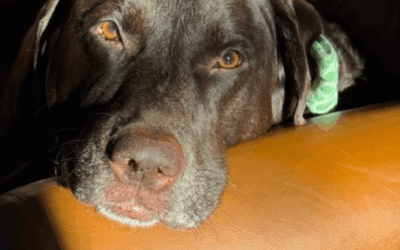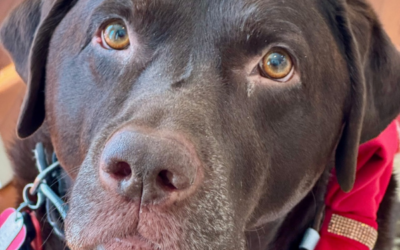Vestibular Syndrome In Dogs And Cats
Jake And Maggie enjoying a nap on the couch in clean, warm blankets out of the dryer 🙂
I have been using Tide Free and Gentle for years now with no dyes or perfumes. A vet recommended it to me when my first dog, Bear, was suffering with allergies.
Bow ties are from Pampered Pooches! Use code “twolabs” for 10% off your order.

Vestibular disease refers to a sudden, non-progressive disturbance of balance. It is more common in older dogs. It is also referred to as old dog vestibular syndrome and canine idiopathic vestibular syndrome.
Most dogs present with the sudden onset of loss of balance, disorientation, head tilt, and irregular jerking eye movements called nystagmus. Many dogs will become reluctant to stand or walk. Most dogs will lean or fall in the direction of their head tilt.
What causes vestibular disease?
Causes of vestibular disease include middle or inner ear infections, drugs that are toxic to the ear, trauma or injury, tumors, and hypothyroidism. When no specific cause is found, the condition is called idiopathic vestibular syndrome. These cases are distinguished by the sudden onset of clinical signs and the subsequent rapid improvement with little, if any, medical intervention.

Causes of Vestibular Disease in Dogs
Various causes of vestibular disease in dogs include:

Diagnosis is based on medical history, clinical signs, and the results of blood and urine tests. In some cases, diagnostic testing might include blood pressure measurement, or radiographs (X-rays) of the head to assess the appearance of the middle and inner ears and the tympanic bullae. Occasionally, magnetic resonance imaging (MRI) or computed tomography (CT) scans will be performed to look for tumors or other abnormalities. Brainstem auditory evoked response (BAER) testing may also be performed in some patients.


Treatment is directed at the underlying cause, if one can be identified. In severe cases, supportive therapy such as intravenous fluids and hospitalization may be required until the dog can eat and walk on its own. If the dog is seriously disoriented or ataxic (stumbling, unable to stand or walk), it may be given sedatives to help it relax. Drugs that help combat nausea or motion sickness may be beneficial. Antibiotics may be used in cases suspected of having middle or inner ear infections. Although corticosteroids have been used in the past, there is little scientific evidence to support their use in this condition and are generally not recommended.
What is the prognosis for a dog diagnosed with vestibular disease?
The clinical signs associated with vestibular disease are often most severe during the first twenty-four to forty-eight hours. Many pets begin to improve within seventy-two hours. The head tilt and stumbling often improve over a seven to ten-day period. Most patients are completely recovered within two to three weeks, although some will have residual symptoms such as a head tilt or mild “wobbling” for life.
If the patient fails to improve or worsens, then a more severe underlying disorder should be suspected, and advanced diagnostic testing should be pursued. A referral to a veterinary neurologist may be advised. You should see a vet immediately if your dog or cat shows any of these signs mentioned above.


I’m Bobbi Jo, a lab-lover who took my passion for animals and dogs and turned it into something bigger. When I adopted Jake and Maggie, my love for them became the driving force behind Two Adorable Labs, and my blog was born. My hope is to not only share them with the world, but to help educate others on the importance of animal health and well-being.
I love hearing from all of you and do my best to respond to each and every one of you. I always enjoy your comments, feedback, and suggestions so keep them coming! If I’ve posted a recipe (for our human and our furry friends) and you try it, don’t forget to tag me on Instagram @twoadorablelabs and use #twoadorablelabs.
If you do try and love my recipes, I would greatly appreciate a comment and rating. I read every single one and respond to them. It also lets Google know that the website contains quality content. The more comments and 5-star ratings, the more Google will show my blog in search results! Thank you so much!
As an Amazon Associate, I earn from qualifying purchases.

You Might Also Like
Help Jasmine Get Adopted!
Jasmine A sweet pitbull named Jasmine is sitting at the Hancock County Animal Shelter waiting for adoption. My cousin adopted Jasmine from this shelter two years ago. Sadly, my cousin passed away recently, and the police were instructed to take Jasmine directly...
Air Quality & Pets: How To Stop Your Home From Getting Musty & Smelly
As absolutely amazing as a pet is, you can’t deny that they may give your home a certain odor. You know what we’re talking about; there’s a mustiness that comes with having a pet, which can make the quality of the air feel almost thick and a bit harder to breathe in....
What Is A Velcro Dog?
Happy Wednesday, everyone! Today we are asking…What Is A Velcro Dog? All dogs have different cuddling styles and ways of showing affection. Jake loved being near me, and his favorite spot was on the couch, lying with his head in my lap while I massaged his ears and...
Cancer In Dogs
Happy Wednesday, everyone. Today, we're discussing cancer in dogs and what to look for. But first, I want to give a big thank you to all of you who called, sent texts, emails, and cards over Jake’s passing. Mr. TAL and I received messages from all over the world,...
Rest In Peace, My Sweet Jake
Today I write with overwhelming sadness as I pay tribute to our Jake. His sudden passing has left us heartbroken. My words can’t describe the pain we feel without him. Jake passed away last week from a large cancerous mass on his spleen that ruptured, metastasized,...
Sick Day? How to Stay Nourished While You Recover
Happy Wednesday, everyone! Sick Day? How to Stay Nourished While You Recover When you're feeling under the weather, your body shifts into a healing mode. This requires the right fuel so that you can feel as well as possible as quickly as possible. While your appetite...







0 Comments